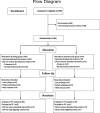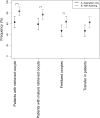Follicular flushing leads to higher oocyte yield in monofollicular IVF: a randomized controlled trial
- PMID: 32856073
- PMCID: PMC7518713
- DOI: 10.1093/humrep/deaa165
Follicular flushing leads to higher oocyte yield in monofollicular IVF: a randomized controlled trial
Abstract
Study question: Does follicular flushing increase the number of mature oocytes in monofollicular IVF?
Summary answer: Follicular flushing increases the number of mature oocytes in monofollicular IVF.
What is known already: Flushing increases neither the oocyte yield nor the pregnancy rate in polyfollicular IVF or in poor responder patients. In monofollicular IVF, the effect of flushing has so far been addressed by two studies: (i) a prospective study with minimal stimulation IVF demonstrated an increased oocyte yield, and (ii) a retrospective study with natural cycle (NC)-IVF showed an increased oocyte yield and an increased transfer rate.
Study design, size, duration: Randomized controlled trial including 164 women who were randomized for either aspiration with or without flushing from 2016 to 2019.
Participants/materials, setting, methods: Infertile women 18-42 years of age with an indication for IVF treatment at a university-based infertility unit. Women undergoing monofollicular IVF were randomized to either follicular aspiration only or follicular aspiration directly followed by five follicular flushes at a 1:1 ratio. The intervention was done without anaesthesia, using a gauge 19 single-lumen needle. Flushing volume was calculated (sphere formula) based on the size of the follicle.
Main results and the role of chance: A total of 164 women were included; 81 were allocated to 'aspiration only' and 83 to additional 'flushing'. Primary analysis was based on the intention-to-treat: oocyte yield, defined as the collected mature oocyte rate, was higher (n = 64/83, 77.1%) in the flushing group compared to the aspiration only group (n = 48/81, 59.3%, adjusted risk difference (RD): 18.2% (95% CI 3.9-31.7%), P-value = 0.02). In the flushing group, most oocytes were retrieved within the first three flushes (63/83, 75.8%). Fertilization rate was higher in the flushing group (n = 53/83, 63.9% vs n = 38/81, 46.9%; adjusted RD: 16.8% (96% CI 1.5-31.4%), P = 0.045). Transfer rate was also higher in the flushing group (n = 52/83, 62.7% vs n = 38/81, 46.9%; RD: 15.71 (95% CI 0.3-30.3%)), but the difference was not significant (P = 0.06). The clinical pregnancy rate n = 9/83 versus n = 9/81 (RD: -0.3% (95% CI -9.9% to 9.5%)) and live birth rate n = 7/83 versus n = 8/81 (RD: -1.5% (95% CI -10.4% to 7.1%)) were not significantly different between the flushing and the aspiration group. The median duration of the intervention was significantly longer with flushing (2.38 min; quartiles 2.0, 2.7) versus aspiration only (0.43 min; quartiles 0.3, 0.5) (P < 0.01). There was no significant difference in the mean (±SD) visual analogue scales pain score between the follicular flushing (3.4 ± 1.8) and the aspiration group (3.1 ± 1.89).
Limitations, reasons for caution: Blinding of the procedure was not possible.
Wider implications of the findings: Our study proved that flushing of single follicles in NC-IVF increases the oocyte yield. In contrast to polyfollicular IVF flushing seems to be beneficial in a monofollicular setting if the technique used in our study (single-lumen needle, 5 flushings with flushing volume adaptation) is applied.
Study funding/competing interest(s): The study was funded by the financial sources of the division and in part by a research grant provided by NMS Biomedical SA, Switzerland. The company did not have any roles in design or conduct of the study or in the preparation of the manuscript. The authors have no other conflicts of interest.
Trial registration number: Clinicaltrials.gov NCT02641808.
Trial registration date: 29 December 2015.
Date of first patient’s enrolment: 22 August 2016.
Keywords: IVF; follicular flushing; live birth rate; monofollicular IVF; oocyte yield; single-lumen needle.
© The Author(s) 2020. Published by Oxford University Press on behalf of European Society of Human Reproduction and Embryology.
Figures



References
-
- Carlsson AM. Assessment of chronic pain: I. Aspects of the reliability and validity of the visual analogue scale. pain1983;16:87–101. - PubMed
-
- Ferraretti AP, La Marca A, Fauser BCJM, Tarlatzis B, Nargund G, Gianaroli L; ESHRE working group on Poor Ovarian Response Definition. ESHRE consensus on the definition of ‘poor response’ to ovarian stimulation for in vitro fertilization: the Bologna criteria. Hum Reprod 2011;26:1616–1624. - PubMed
-
- Haydardedeoglu B, Gjemalaj F, Aytac P, Kilicdag E.. Direct aspiration versus follicular flushing in poor responders undergoing intracytoplasmic sperm injection: a randomised controlled trial. BJOG 2017;124:1190–1196. - PubMed
Publication types
MeSH terms
Associated data
LinkOut - more resources
Full Text Sources
Medical
Research Materials
Miscellaneous

